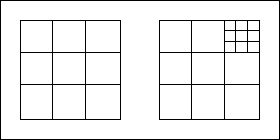|
One of tht ideals of origami demands folding an initial square without the preliminary drawings and measurements. At such folding there is a problem in case if it is necessary to fold the sheet of a paper, for example, on three equal parts. How to make it, not resorting to a pencil? In given paper the question of division of the side of square paper sheet on two, three, four, ... ten equal parts is considered.
The division of the paper sheet into two parts does not represent complexity, as is realized simply by folding of the book base form. Let's pass to more complex task of division the square sheet on three parts.
This task is not so simple. For its decision we will need the Haga's theorem. Let's fold the corner of the square to middle of the opposite side. In such case the point of crossing other side opposite to this corner with the side, adjacent to it divides the side in the ratio one to two. Thus, with only creases we have divide the side of a square on three parts.
The following task - division of the side of a square into four equal parts. For this purpose it is enough to divide them in half, and then, each of halves again in half. So occurs, when we fold the door base.
As it is easy to guess, division of a square into five parts with the help of folding represents much more difficult task. Its decision is represented in picture. Try to prove, that by this way we really shall divide a square into five parts. A bit later I shall bring the proof of this theorem.
To divide the side of square into six parts, it is enough to us to divide it into three parts, as it was shown earlier. And, then, each of parts to divide in half.
It is possible to notice, that the special complexities are caused by division of a square into amount of parts being simple number. Let's begin division of the side into seven identical parts. For this purpose at first we shall divide a square into five equal parts, and then, we shall make action represented on picture.
The division of the square into eight equal parts is absolutely simple. For this purpose it is enough to divide it into four equal parts, and then, each of them to divide in half.
For division into nine equal parts it is possible to propose two ways. First of them consists in dividing at first into three equal parts, and then to repeat division into three for a small square. However this way semms to my as bad because it will be difficult to provide sufficient accuracy, as the errors appended at different stages.
The other way is more original and is based on development of the Hara's theorem, which has offered by Koji and Micue Fushimi. Let's notice, that this way was applied at division of a square on seven and nine parts.
And, at last, division into ten parts represents consecutive division into five parts, and then division in half each of the five parts.
|









